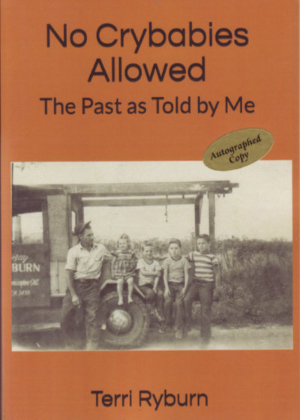 I know Terri Ryburn as the owner of historic Sprague’s Super Service in Normal, Illinois, and as a key ingredient in the Miles of Possibility Route 66 Conferences. I know the picture on the cover of the book from a copy hanging on the wall of the former gas station that Ryburn has turned into a Route 66 information center, gift shop, and photo op. I knew that was Terri seated on the fender with her dad and older brothers standing beside her because she told me when I spotted the photo on the wall. She may have told me that the photo contained only half of her total family but if she did I forgot. From reading No Crybabies Allowed I learned (or maybe relearned) that, while Terri was the youngest family member in this particular photo, she would be in the elder half of eight children after two more brothers and two sisters came along. None were crybabies.
I know Terri Ryburn as the owner of historic Sprague’s Super Service in Normal, Illinois, and as a key ingredient in the Miles of Possibility Route 66 Conferences. I know the picture on the cover of the book from a copy hanging on the wall of the former gas station that Ryburn has turned into a Route 66 information center, gift shop, and photo op. I knew that was Terri seated on the fender with her dad and older brothers standing beside her because she told me when I spotted the photo on the wall. She may have told me that the photo contained only half of her total family but if she did I forgot. From reading No Crybabies Allowed I learned (or maybe relearned) that, while Terri was the youngest family member in this particular photo, she would be in the elder half of eight children after two more brothers and two sisters came along. None were crybabies.
I didn’t care much for the book’s title when I first saw it. I may have liked it even less after encountering it in the text for the first time. Terri’s brothers started a “boys only” club which she, of course, wanted to join. When being told that girls were not allowed brought on tears, they told her that there were no crybabies allowed either. I was still calibrating the book in my mind at that point and I seriously feared that I was in for many pages of the boys driving their sister to tears then laughing at her or her refusing to let tears actually form to prove she was no crybaby. By then I’d read enough to know better but I guess I just didn’t.
But it wasn’t long before an entirely different view of the title started to form. The Ryburns were poor. Often very poor. Often very very poor. They lived in an apartment when Terri was born but were soon living in a tent and carrying water from a neighboring house. It was quite a step up when her father built “a windowless 10′ x 16′ tarpaper shack”. I’ve read more than a few tales of people living in poverty. It often seems like the writers make lots of comparisons and toss around adjectives to stress just how poor someone is. That is infrequently the case here. Situations are described in enough detail that comparisons can easily be made but they are not forced. I don’t believe there is a single instance of “we were so poor that…”. I began to think of the book’s title as Terri’s instruction to herself. Tell your story accurately but don’t whine about it.
The family’s financial situation was not helped by Ray Ryburn’s wanderlust. Their frequent moves over the western two-thirds of the country were always instigated by Terri’s father, sometimes with apparent justification and sometimes not. A typical move had them downsizing their already meager belongings to fit into whatever timeworn vehicle was in their possession at the time then cramming themselves into what space was left while Hazel Ryburn counted her offspring as they boarded to make sure none were left behind. That seems a little like the Joads and I don’t doubt that there were times when the Ryburns in transit resembled people fleeing the dust bowl a couple of decades earlier.
No Crybabies Allowed is autobiographical. It covers the first dozen years of Terri Ryburn’s life in chronological order. However, it is done with anecdotes that, in many cases, could stand alone as short stories of life in the 1950s or of being a child in any decade. Some, like the neighborhood prayer meeting, are hilarious. Others are about as far from funny as it is possible to be.
While the Ryburns are living in San Francisco, a very young Terri is invited to a prayer meeting by a Spanish-speaking neighbor. As the adult women pray loudly with hands in the air, a non-Spanish-speaking Terri joins them. For the most part, she relies on copying the other voices with a syllable or so lag but she also tosses in a few phrases of her own (e.g., caballero dog) that she learned by watching Zorro on TV. Some of the emotional women had begun to cry but the tears stopped as they opened their eyes to look at the enthusiastic visitor. Ending the crying, she decided, was proof that her prayers were working.
For an example of something at the other end of the scale, the bonfire scene as they prepare to leave Illinois for California is one that sticks in my mind. The bonfire is the final step in downsizing. Useless furniture and other items not making the trip go into the fire. The boys make a game of tossing their few toy cars and trucks into the fire. The same fate has been decreed for Linda, Terri’s doll. Terri at first refuses but eventually tosses the doll into the flames while tears flow. Linda has been through some rough times including the brothers using her head for a ball just a few pages earlier. She’s in pretty bad shape and somehow considering the doll’s sorry condition makes the toss acceptable. Maybe it’s just rationalizing the inevitable but that’s not a bad skill to master when dealing with the inevitable crops up so often. Ryburn didn’t write the following and maybe she didn’t even think it but I did. Sobbing over a doll does not make you a crybaby.
Terri (actually Theressa, I learned) Ryburn and I are about the same age so some of her childhood experiences parallel my own. I remember learning to read with Dick and Jane and I remember ordering books from the Scholastic Book Club. I remember weak Kool-Aid and peanut butter sandwiches. I suppose the familiar bits that brought back my own memories are one reason I enjoyed this book. But Ryburn and I don’t remember these things exactly the same way. I don’t recall ever having a problem getting a few quarters for my Scholastic Book Club order and our Kool-Aid almost always had some sugar in it. And we never moved beyond a few miles and not at all during my school years. Maybe — and I feel a tiny tinge of guilt saying this — I enjoyed the book because it made me appreciate the circumstances of my childhood even more.
The book can be purchased from Amazon via the link at the end but a better way would be to get an autographed copy direct from Terri at Ryburn Place, 305 Pine St, Normal, IL. Terri would also be happy to mail copies. Call (309-585-4103) or email (ryburnplace66@gmail.com) to arrange.
No Crybabies Allowed: The Past as Told by Me, Dr. Terri Ryborn, Independently published (December 9, 2019), 7 x 10 inches, 405 pages, ISBN 978-1093973686
Available through Amazon.

 Amy E. Brownlee is a lifelong Cincinnatian. She naturally learned a lot about the city growing up here then used that knowledge and added much more during her ten years at Cincinnati Magazine. An awful lot of the treasures she writes about in Lost Treasures of Cincinnati were lost before she arrived but a rather frightening number have disappeared during her lifetime. Of course, an even larger number have disappeared during mine. Neither of us is responsible for that. I swear it’s coincidence pure and simple.
Amy E. Brownlee is a lifelong Cincinnatian. She naturally learned a lot about the city growing up here then used that knowledge and added much more during her ten years at Cincinnati Magazine. An awful lot of the treasures she writes about in Lost Treasures of Cincinnati were lost before she arrived but a rather frightening number have disappeared during her lifetime. Of course, an even larger number have disappeared during mine. Neither of us is responsible for that. I swear it’s coincidence pure and simple. The book opens with “Food and Drink” in Section 1 then covers “Entertainment” and “Retail” in the next two sections. The smallest section, “Media”, is followed by the largest, “Community”. Definitions for those section titles are not particularly rigid and the size of the “Community” section probably indicates that it is the least rigid of all. It is where things like churches and breweries, of which Cincinnati had more than a few, appear.
The book opens with “Food and Drink” in Section 1 then covers “Entertainment” and “Retail” in the next two sections. The smallest section, “Media”, is followed by the largest, “Community”. Definitions for those section titles are not particularly rigid and the size of the “Community” section probably indicates that it is the least rigid of all. It is where things like churches and breweries, of which Cincinnati had more than a few, appear.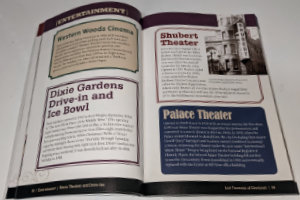 Most, but not quite all, of the breweries mentioned in the book were gone before I got here. Likewise with restaurants and attractions which together comprise the biggest part of things that have disappeared during my lifetime. I caught one show, Hair, at the Shubert (“Entertainment”) before it was torn down. I also saw one movie at the Albee (“Entertainment”) but I don’t remember what it was. I had one meal each at The Gourmet Room and the Maisonette (“Food and Drink”) before they closed. There are quite a few places in this book where I ate one or more meals or watched one or more movies, plays, games, or concerts. Encountering each of them on these pages prompted memories that went way beyond the single paragraph of text. Reading about places that were already gone when I came to Cincinnati didn’t prompt any memories, of course, but it did make me appreciate just how many treasures have been lost.
Most, but not quite all, of the breweries mentioned in the book were gone before I got here. Likewise with restaurants and attractions which together comprise the biggest part of things that have disappeared during my lifetime. I caught one show, Hair, at the Shubert (“Entertainment”) before it was torn down. I also saw one movie at the Albee (“Entertainment”) but I don’t remember what it was. I had one meal each at The Gourmet Room and the Maisonette (“Food and Drink”) before they closed. There are quite a few places in this book where I ate one or more meals or watched one or more movies, plays, games, or concerts. Encountering each of them on these pages prompted memories that went way beyond the single paragraph of text. Reading about places that were already gone when I came to Cincinnati didn’t prompt any memories, of course, but it did make me appreciate just how many treasures have been lost.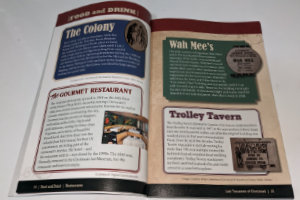 I really enjoyed reading Lost Treasures of Cincinnati cover-to-cover front-to-back but as I did, two other ways of reading the book came to mind. With its fairly short standalone essays, it seems like a natural fit for that popular personal reading room with the porcelain furniture. Its use as a reference book also seems rather natural. I don’t mean an every-last-detail reference book to use in conducting deep-dive research but a great place to answer questions like “What was the name of that boat-shaped restaurant?” or “What happened to our NBA team?”. The full index will help the book play that role.
I really enjoyed reading Lost Treasures of Cincinnati cover-to-cover front-to-back but as I did, two other ways of reading the book came to mind. With its fairly short standalone essays, it seems like a natural fit for that popular personal reading room with the porcelain furniture. Its use as a reference book also seems rather natural. I don’t mean an every-last-detail reference book to use in conducting deep-dive research but a great place to answer questions like “What was the name of that boat-shaped restaurant?” or “What happened to our NBA team?”. The full index will help the book play that role. Greg Hand has been a man of letters — or at least a man of words — his entire adult life. He began as a newspaper reporter, moved up to editor, left to head up a university PR department, co-authored three books about the university while he was there, then retired. I was not even slightly aware of any of this as it was happening. I only became aware of Hand’s existence when I stumbled upon the blog he started post-retirement. His knowledge of local history and ability to dig up information to augment that knowledge was immediately apparent and I’ve been an ardent reader of that blog ever since that happy discovery. The blog’s name is Cincinnati Curiosities and it can be found
Greg Hand has been a man of letters — or at least a man of words — his entire adult life. He began as a newspaper reporter, moved up to editor, left to head up a university PR department, co-authored three books about the university while he was there, then retired. I was not even slightly aware of any of this as it was happening. I only became aware of Hand’s existence when I stumbled upon the blog he started post-retirement. His knowledge of local history and ability to dig up information to augment that knowledge was immediately apparent and I’ve been an ardent reader of that blog ever since that happy discovery. The blog’s name is Cincinnati Curiosities and it can be found 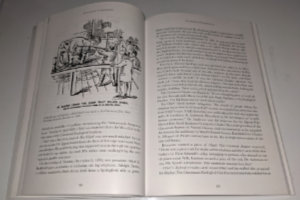 In fact, later in the book, Hand offers another very different capsulated view of the city. On December 12, 1890, he tells us, “The Palace Hotel had elephant steak on the menu because an elephant was executed by firing squad that morning at the Cincinnati Zoo. Hundreds of people watched. That pretty much summarizes Cincinnati in 1890.”
In fact, later in the book, Hand offers another very different capsulated view of the city. On December 12, 1890, he tells us, “The Palace Hotel had elephant steak on the menu because an elephant was executed by firing squad that morning at the Cincinnati Zoo. Hundreds of people watched. That pretty much summarizes Cincinnati in 1890.”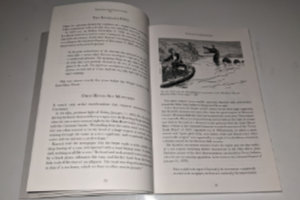 “The Sensational and the Senseless” is the fourth of ten chapters. Other chapters tell of monsters in the Ohio River (“The Old Weird Cincinnati”), Fanny Trollope’s visit during the “Porkoplis” period (“Tales From the Old City”), the possibility that striptease was invented in Cincinnati (“Freaks, Flesh, and Footlights”), and a large variety of other topics. The striptease claim is based on Millie De Leon’s orchestrated removal of several garters in 1901, and Hand cites the claim in suggesting that a Striptease Hall of Fame might be an “appropriate addition to our Over-the-Rhine neighborhood”.
“The Sensational and the Senseless” is the fourth of ten chapters. Other chapters tell of monsters in the Ohio River (“The Old Weird Cincinnati”), Fanny Trollope’s visit during the “Porkoplis” period (“Tales From the Old City”), the possibility that striptease was invented in Cincinnati (“Freaks, Flesh, and Footlights”), and a large variety of other topics. The striptease claim is based on Millie De Leon’s orchestrated removal of several garters in 1901, and Hand cites the claim in suggesting that a Striptease Hall of Fame might be an “appropriate addition to our Over-the-Rhine neighborhood”. 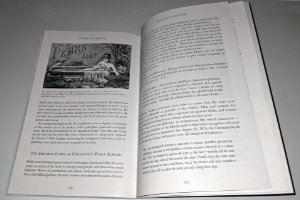 Hand’s usually light-hearted reports are often accompanied by contemporary illustrations. At left is a Pears Soap advertisement based on Lillie Langtry’s famous bath in Apollinaris water at Cincinnati’s Grand Hotel in 1883. It’s in the chapter titled “Nudity, Naughtness, and Negotiable Affection”, and if that doesn’t get you interested in the book I don’t know what will.
Hand’s usually light-hearted reports are often accompanied by contemporary illustrations. At left is a Pears Soap advertisement based on Lillie Langtry’s famous bath in Apollinaris water at Cincinnati’s Grand Hotel in 1883. It’s in the chapter titled “Nudity, Naughtness, and Negotiable Affection”, and if that doesn’t get you interested in the book I don’t know what will.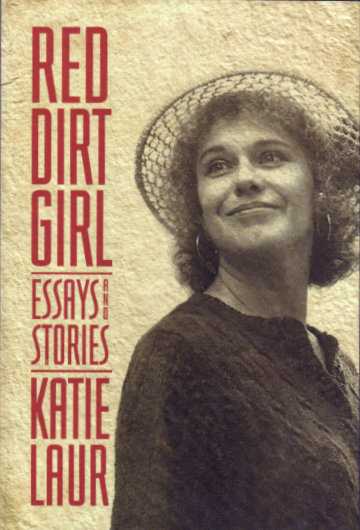 This was one of the most flat-out enjoyable reads I’ve had in a long time. I have seen Katie perform many times, heard her talk on the radio several times, and even chatted with her personally a few times. I knew her as a talented musician and entertaining storyteller but I did not know her as a writer. Others, it seems, have been aware of Laur’s writing skills for some time. It’s my impression that nothing other than the foreword, an introduction, and Katie’s acknowledgments was written specifically for this book. In one of the book’s essays, Katie talks of selling her writing and says she sold everything she wrote. From that, I assume that each of the essays and stories that make up Red Dirt Girl has previously appeared in print somewhere. Where I don’t know and regret that where ever it was, it was outside my field of vision. That I am only now seeing the literary side of Katie is very much my loss. This gal can write.
This was one of the most flat-out enjoyable reads I’ve had in a long time. I have seen Katie perform many times, heard her talk on the radio several times, and even chatted with her personally a few times. I knew her as a talented musician and entertaining storyteller but I did not know her as a writer. Others, it seems, have been aware of Laur’s writing skills for some time. It’s my impression that nothing other than the foreword, an introduction, and Katie’s acknowledgments was written specifically for this book. In one of the book’s essays, Katie talks of selling her writing and says she sold everything she wrote. From that, I assume that each of the essays and stories that make up Red Dirt Girl has previously appeared in print somewhere. Where I don’t know and regret that where ever it was, it was outside my field of vision. That I am only now seeing the literary side of Katie is very much my loss. This gal can write.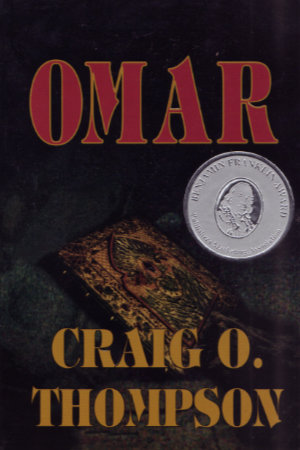 This makes two consecutive book reviews that are seriously belated and that’s hardly their only connection. I wasn’t even aware of either the book or its author when I arrived at the 2022 Lincoln Highway Association conference but, John Jackson, co-author of
This makes two consecutive book reviews that are seriously belated and that’s hardly their only connection. I wasn’t even aware of either the book or its author when I arrived at the 2022 Lincoln Highway Association conference but, John Jackson, co-author of 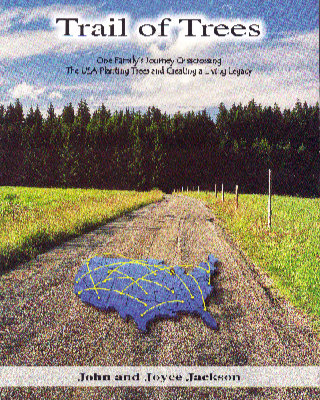

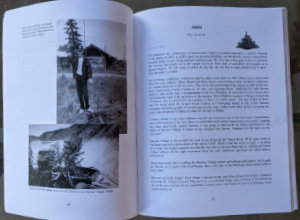
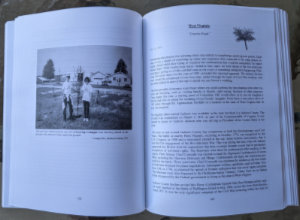
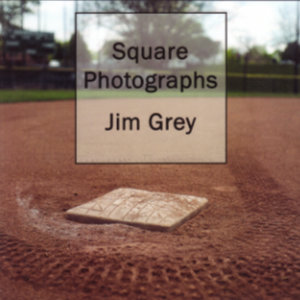
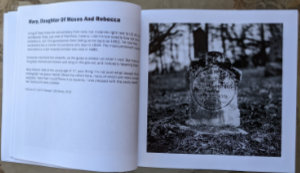
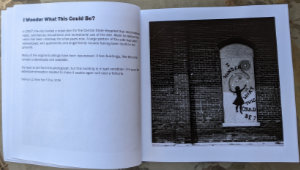
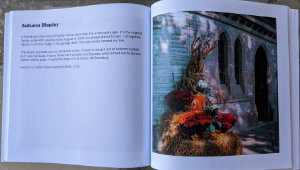
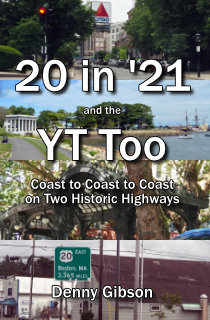 Missed it by that much. I had this really great idea for a book title, and even figured out the story that would fit it. I would drive one way across the country on the Yellowstone Trail and the other way on US 20. I would do this in the year 2020, and the resulting travelogue would be perfectly described by that catchy title: 20 in ’20 and the YT Too. But COVID-19 played havoc with 2020 travel plans and the wonderful title’s “best if used by” date came and went. I made the planned trip a year later and adjusted the title appropriately. It’s admittedly not quite the same but it’s not horrible. Is it? Well?
Missed it by that much. I had this really great idea for a book title, and even figured out the story that would fit it. I would drive one way across the country on the Yellowstone Trail and the other way on US 20. I would do this in the year 2020, and the resulting travelogue would be perfectly described by that catchy title: 20 in ’20 and the YT Too. But COVID-19 played havoc with 2020 travel plans and the wonderful title’s “best if used by” date came and went. I made the planned trip a year later and adjusted the title appropriately. It’s admittedly not quite the same but it’s not horrible. Is it? Well? This post is a direct violation of one of the claims made on this blog’s “About” page. There the claim is made that “You will not be seeing a review of the latest novel…”. I suppose I could claim that, at the time of this review, The Lincoln Highway: A Novel is no longer the absolute latest novel, but the fact that it is a “#1 New York Times Best Seller” means it is precisely the sort of mainstream major publisher offering I had in mind when I made that claim. My primary defense is that I was tricked into reading it. Realizing that not everyone will see that as a legitimate justification, I will try to minimize the impact of the violation by not doing a very good job.
This post is a direct violation of one of the claims made on this blog’s “About” page. There the claim is made that “You will not be seeing a review of the latest novel…”. I suppose I could claim that, at the time of this review, The Lincoln Highway: A Novel is no longer the absolute latest novel, but the fact that it is a “#1 New York Times Best Seller” means it is precisely the sort of mainstream major publisher offering I had in mind when I made that claim. My primary defense is that I was tricked into reading it. Realizing that not everyone will see that as a legitimate justification, I will try to minimize the impact of the violation by not doing a very good job. I got this book from Billy on May 7, 2015. I finished reading it on March 15, 2022. It is, as Billy himself admits and my elapsed reading time confirms, “a difficult read”. “Most people,” he says, “have understandably given up on it.” I was determined not to be like most people — no matter how long it took.
I got this book from Billy on May 7, 2015. I finished reading it on March 15, 2022. It is, as Billy himself admits and my elapsed reading time confirms, “a difficult read”. “Most people,” he says, “have understandably given up on it.” I was determined not to be like most people — no matter how long it took.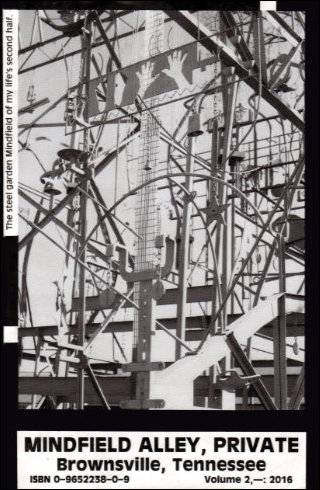 The book has been called a semi-autobiographical novel. According to Billy, it tells about his early life. “The best story I can tell in words is there if one really wants to know it”, he says. The writing style has been called stream of consciousness. In some manner, “stream of consciousness” and “semi-autobiographical” might also apply to the giant metal sculpture that is his life work. Its picture is on the book’s back cover. It is what initially made me and most others aware of Billy’s existence. When I first happened upon the sculpture in 2005, I thought its name, “Billy Tripp’s Mindfield”, might have been the title of a misplaced Beatles song, and learning that William Blevins Tripp is the artist’s real name has not entirely erased that image.
The book has been called a semi-autobiographical novel. According to Billy, it tells about his early life. “The best story I can tell in words is there if one really wants to know it”, he says. The writing style has been called stream of consciousness. In some manner, “stream of consciousness” and “semi-autobiographical” might also apply to the giant metal sculpture that is his life work. Its picture is on the book’s back cover. It is what initially made me and most others aware of Billy’s existence. When I first happened upon the sculpture in 2005, I thought its name, “Billy Tripp’s Mindfield”, might have been the title of a misplaced Beatles song, and learning that William Blevins Tripp is the artist’s real name has not entirely erased that image.